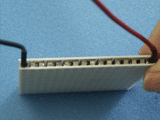A Peltier device (Picture 1) is operated as a thermoelectric generator: It is placed between a hot and a cold body of water (Picture 2). As a result, a voltage is set up across the terminals of the device. When an electric appliance is hooked up to the generator, the appliance runs.
Here, an ohmic resistor is used as appliance. The temperatures of the two bodies of water are measured as functions of time, and so are voltage and electric current. The electric power is calculated and plotted as a function of the square of the temperature difference between the bodies of water (graph). | | 
Click to obtain pdf for printing a. How is the electric power determined? How does it depend upon the voltage across the load resistor? b. Assume that the energy for driving the electric process comes from entropy flowing (downhill) from the hot to the cold body of water. Draw a process diagram that corresponds to this idea. Turn this into a formula for the power of the fall of entropy from high to low temperature. c. Does the idea generated in b correspond to the observation that the electric power of the Peltier device depends linearly upon the square of the temperature difference (see the graph)? Can this be compared to how electric power is calculated in a? d. If you accept the reasoning in c, what does this mean for the entropy current flowing from the hot to the cold body of water, i.e., how should it depend upon the temperature difference? |


